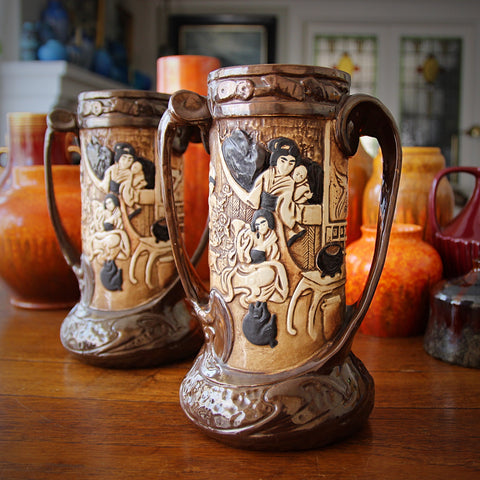In the Nineteenth Century, imported Chinese ceramics were all the rage in Europe (especially England). But these costly treasures were beyond the reach of all but the wealthiest collectors. British ceramics workshops began to make goods "in the Oriental style," for the domestic market. Rarely were these pieces authentic. In fact, they were usually over-the-top. And they almost never reached the quality of true Chinese ceramics in form, glaze or handcraft. But they did allow customers of modest means to acquire a small dash of far-away style—a taste of someplace exotic, on the other side of the world, which they could never enjoy visiting in-person. Rather than condemn these pieces as "exploitive Orientalism," I prefer to view them as Eastern aesthetics as re-interpreted, translated through a Western artist's eyes. When one people (or culture) appreciates and adapts another culture's beauty, is it admiration or exploitation? Imitation has always been the sincerest form of flattery.
The pair of vases, shown above, were made by Henry Tooth at Bretby. Tooth previously had worked with avant-garde designer, Dr. Christopher Dresser, at the cutting-edge ceramics workshop, Linthorpe. In 1883, Tooth and William Ault (also from Linthorpe) began producing their own wares, in a studio they shared with another pottery. Success was quick. Within a year they were awarded a Gold Medal at the London International Universal Exposition. Within two years, they had moved into their own workshop premises in Woodville, Derbyshire. But the partnership was not to last. In 1887, William Ault founded his own, separate ceramics manufactory. Henry Tooth took the opportunity to greatly expand the Bretby product line. Over the years they produced a wide range of goods, from art wares to utilitarian kitchen canisters. Some of Bretby's works were hand-thrown, though the vast majority of their goods were "pressed" in moulds. Painting was done by hand, almost exclusively by women.
One of Bretby's strengths was its attempt to emulate—in ceramic—other materials like metal, wood, jewels, or cloisonné. The vases above show Bretby's bas relief treatment reminiscent of a carved Chinese screen. While the sculpting is highly flamboyant, the coloring helps rein-in the exuberance. Sweeping, Art Nouveau "whiplash" handles frame the scenes: a depiction of a Chinese court and a Chinese village (on the opposite side). Designed around the Turn-of-the-Twentieth-Century, these vases straddle the Victorian era's maximalism (and fascination with all things Asian) and the Early Twentieth Century's Western Art Nouveau Movement. Click on the photo above to learn more about these dramatic vases.
Though our Greenwich Village store is now permanently closed, LEO Design is still alive and well! Please visit our on-line store where we continue to sell Handsome Gifts (www.LEOdesignNYC.com).
We also can be found in Canonsburg, Pennsylvania, at The Antique Center of Strabane (www.antiquecenterofstrabane.com).
Or call to arrange to visit our Pittsburgh showroom (by private appointment only). 917-446-4248


